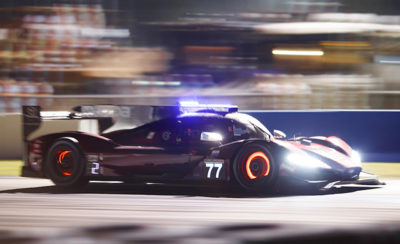Mazda Team Joest drivers explain that late braking isn’t always the best braking
“I have to say, I’m one of those drivers … I want to brake as late as possible everywhere; but it’s definitely not always the quickest way.”
That’s Oliver Jarvis, one of Mazda Team Joest’s ace drivers in the No. 77 RT24-P that competes in the WeatherTech SportsCar Championship. He speaks to the racing driver’s instinct that carrying speed as long as possible, and spending as little time on the brakes as necessary, is the ideal. For some corners it is. For others, there’s a bit of finesse involved.
“Sometimes I’ll look at the data with my teammates, and I’m 10 or 15 meters later on the brakes, gain two-tenths on the way in, but lose two-and-a-half on the way out. The thing you learn is it’s always nice to be late on the brakes and, once you get used to that mentality, it’s hard to step away from that. Sometimes when I brake where I see teammates or other competitors, for me it doesn’t feel right; I feel like I’m not pushing it into the corner. But you’ve got to appreciate when to brake late,” Jarvis continues.
There are many nuances to braking that can make a huge difference in lap times, or come into play in getting a fast lap time vs. racing against other competitors. There’s the classic brake-late-and-hard-in-a-straight-line that many racers start with, and for many corners, it’s the right technique. But there are others ways to work corners, like trail braking, light braking with an early release, releasing the brake sharply to add rotation, stabbing the brake to set the front on turn-in – it depends not only on the corner, but also the corner that comes next.
“If you have a tight hairpin and you have a very short straight after, you can afford to brake late and have a bad exit because you don’t get punished down the straight. But if you’ve got a hairpin and you have a really long straight after, the key is in the exit because you’ll gain more time by getting a strong exit since the time gain will go all the way down the straight,” explains Jarvis.
Finding the right technique and braking points comes through trial and error, and applying lessons learned in similar corners to the track you’re trying to learn. It starts by studying the track as intimately as possible.
“You can really get a feel for the type of corner based on a track walk,” says Tristan Nunez, Jarvis’s partner in the No. 77 RT24-P. “You get a sense of, OK, this is a high-speed corner, I don’t need a lot of brake and I can let the car be in kind of a neutral state and just let the car do the work. If it’s a sharper corner, you know that you need to slow the car down; if it’s after a long straightaway, you need to work yourself up to it.
“One guy that’s been driving there for 20 years may be telling you to brake at the 100 marker; that may be something he’s done in perfect conditions and it may not be the same that day,” he continues. “The best thing may be to brake at the 300 marker as hard as you can and you’ll feel as if you’re over-slowing, but you can work your way up to the 100 marker. The second you out-brake yourself and throw it off the track, your confidence goes sideways. It’s better to work your way up slowly, every lap taking little chunks.”
Then, if you have the option, look at the data or video to figure out what you did that worked best.
“After every session, I’ll sit down and analyze every detail,” says Jarvis. “Am I braking too late, too early? And I look at different laps as well, because everybody focuses on that quickest lap, but sometimes you got it right on lap four without even realizing it. It’s trying to maximize every little detail. For me, braking is a real art form.”


 ACCESSIBILITY
ACCESSIBILITY